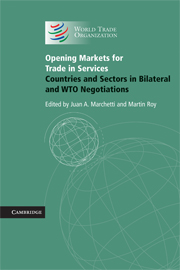Book contents
- Frontmatter
- Contents
- List of figures
- List of tables
- List of boxes
- List of contributors
- Foreword
- Acknowledgments
- Disclaimer
- Summary and overview
- PART I From Policy to Negotiations
- PART II Multilateral and Bilateral Negotiations on Services: Overall Perspectives
- PART III Challenges, Issues and Opportunities in Services Sectors
- 4 Telecommunications: can trade agreements keep up with technology?
- 5 The liberalization of cross-border trade in services: a developing country perspective
- 6 Out of stock or just in time? Doha and the liberalization of distribution services
- 7 Air transport liberalization: a world apart
- 8 Financial services liberalization in the WTO and PTAs
- 9 Beyond the main screen: audiovisual services in PTAs
- 10 The liberalization of postal and courier services: ready for delivery?
- 11 The liberalization of energy services: are PTAs more energetic than the GATS?
- 12 Market access for the government procurement of services: comparing recent PTAs with WTO achievements
- 13 A warmer welcome? Access for natural persons under PTAs
- PART IV Country Experiences with Services Trade
- Index
- References
9 - Beyond the main screen: audiovisual services in PTAs
Published online by Cambridge University Press: 05 December 2011
- Frontmatter
- Contents
- List of figures
- List of tables
- List of boxes
- List of contributors
- Foreword
- Acknowledgments
- Disclaimer
- Summary and overview
- PART I From Policy to Negotiations
- PART II Multilateral and Bilateral Negotiations on Services: Overall Perspectives
- PART III Challenges, Issues and Opportunities in Services Sectors
- 4 Telecommunications: can trade agreements keep up with technology?
- 5 The liberalization of cross-border trade in services: a developing country perspective
- 6 Out of stock or just in time? Doha and the liberalization of distribution services
- 7 Air transport liberalization: a world apart
- 8 Financial services liberalization in the WTO and PTAs
- 9 Beyond the main screen: audiovisual services in PTAs
- 10 The liberalization of postal and courier services: ready for delivery?
- 11 The liberalization of energy services: are PTAs more energetic than the GATS?
- 12 Market access for the government procurement of services: comparing recent PTAs with WTO achievements
- 13 A warmer welcome? Access for natural persons under PTAs
- PART IV Country Experiences with Services Trade
- Index
- References
Summary
Audiovisual services have long been a sensitive issue in the WTO, where key members have traditionally held very divergent views. It is not surprising therefore that this sector has failed to attract either a significant number of commitments under the GATS or offers in the Doha Round. Indeed, only twenty-nine members have commitments, while only eight had made offers by the end of 2007. In comparison, preferential trade agreements have provided for significant advances: audiovisual is one of the sectors in which the contrast between multilateral and preferential commitments is the greatest, especially in bilateral agreements where the United States is involved.
The audiovisual commitments undertaken in PTAs have a number of significant characteristics, which may result, on the one hand, from the lesser polarization that this topic attracts in bilateral negotiations compared to the WTO context and, on the other hand, from market and technological advances that have transformed the way in which audiovisual services are delivered and consumed. First, while GATS commitments tend to reflect an “all or nothing” approach whereby a number of members seek full discretion across the whole sector because of its cultural characteristics, PTA commitments have often been crafted so as to take into account policy objectives and sensitivities of both an economic and cultural nature; certain areas remain protected, but guarantees of access are given in other parts of the market.
- Type
- Chapter
- Information
- Opening Markets for Trade in ServicesCountries and Sectors in Bilateral and WTO Negotiations, pp. 340 - 377Publisher: Cambridge University PressPrint publication year: 2009
References
- 2
- Cited by



